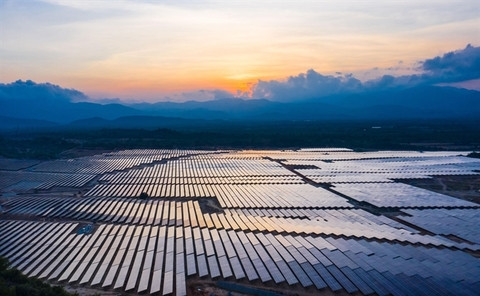
Trung Nam Thuan Nam Solar Farm. EVN ceased to purchase 172 MW of electricity generated by the farm last year. — VNA/VNS Photo
Demand-supply imbalance is putting upward pressure on electricity prices in Viet Nam, yet a large amount of renewable energy cannot pick up the slack due to regulatory challenges.
Project developers incur a cost of around US$3 billion for every 1 GW of renewable energy generated in the country. However, about 4 GW of the energy did not have a Feed-in Tariff last year, costing them approximately $12 billion without generating any revenue in return.
Meanwhile, the loans that project developers take out from credit institutions are not free of charge. They entail regular interest payments and normally come due after three years, putting many no-revenue solar and wind farms in financial distress.
As such, project developers are calling for a free electricity market, under which power producers have the leeway to negotiate power prices with global corporations and sell their renewable energy directly to them, replacing the current mechanism under which Vietnam Electricity is designated as the sole buyer.
In fact, the Ministry of Industry and Trade (MOIT) has planned to develop such a market since 2022. Under the plan, customers would be free to choose their electricity producers by 2024. Experts are urging lawmakers to issue a Law on Renewable Energy and Law on Energy Transition, as well as amend the Law on Bidding and Law on Prices, to lay the groundwork for the market.
On September 1, 2022, the sale of 172 MW out of 450 MW generated by Trung Nam Thuan Nam Solar Farm was turned down by EVN. The discontinuation of the electricity purchase costs the farm around VND2 billion ($85,000) day by day.
The provincial authority of Ninh Thuan has sent appeals to MoIT, asking the ministry to order EVN to continue purchasing the amount of energy generated by the solar farm. MoIT has requested EVN to do so but no action has been taken by the electricity corporation so far.
By late 2022, 4,126 MW of wind energy and 16,545 MW of ground-mounted solar energy, accounting for 27 per cent of domestic renewable energy capacity, have been connected to the national grid.
Before the expiration of Feed-in Tariffs, solar energy was purchased at a price of between 7.09 to 9.35 cents per kWh, and wind energy between 8.35 to 9.8 cents per kWh.
Solar and wind farms that failed to achieve commercial operation prior to the expiration will have to negotiate new tariffs with EVN by reference to ceiling prices.
The ceiling prices were set between 5.05 cents to 6.43 cents for solar projects, and between 6.77 cents to 7.75 cents for wind projects. Project developers said the price caps are lower than the old FITs and they are unable to operate profitably with such low caps.
In his meeting with Standard Chartered on February 9, Prime Minister Pham Minh Chinh requested the bank to offer financial products with preferential terms to green and renewable energy projects in Viet Nam to support the country in its fight against climate change.
He also said that the country has developed its master plan for renewable energy, under which the energy is expected to drive down electricity prices to the level of other power sources. — VNS